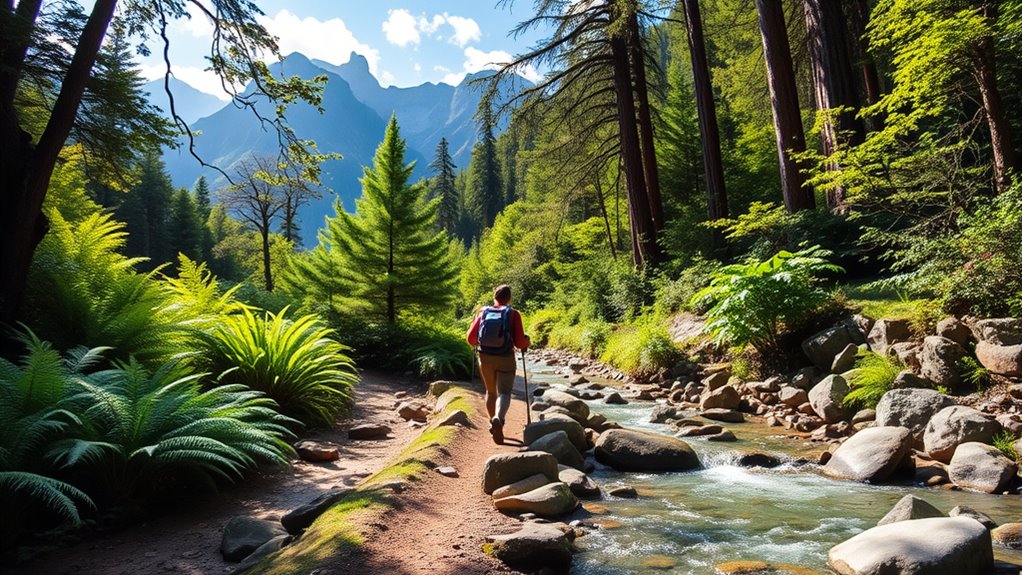Low-impact hiking in Fiordland National Park lets you explore breathtaking landscapes while preserving the environment. Always stick to designated trails to protect native flora and avoid soil erosion. Keep a respectful distance from wildlife and never feed the animals to maintain their natural behaviors. Dress for changing weather, inform someone about your plans, and stay safe while enjoying the park. There’s so much more to discover about hiking responsibly in this stunning wilderness.
Key Takeaways
- Stay on designated trails to protect native flora and prevent soil erosion in the delicate ecosystem of Fiordland National Park.
- Avoid collecting specimens and disturbing plants to maintain the health of the park’s diverse flora and ecosystem.
- Prepare for changing weather by dressing in layers and carrying waterproof gear to ensure a safe hiking experience.
- Observe wildlife from a distance and never feed animals to respect their natural behaviors and habitats.
- Use reliable navigation tools, like maps and charged phones, to safely navigate the trails while minimizing environmental impact.

Hiking in Fiordland National Park is an adventure that promises breathtaking landscapes and unforgettable experiences. As you venture into this stunning wilderness, you’ll encounter towering mountains, pristine lakes, and diverse ecosystems teeming with life. To make the most of your journey, it’s crucial to embrace low-impact hiking practices that respect the environment while ensuring your safety on the trails.
Experience breathtaking landscapes and diverse ecosystems in Fiordland National Park while practicing low-impact hiking for a safe and respectful adventure.
The flora diversity in Fiordland is truly remarkable. You’ll find everything from ancient beech forests to vibrant alpine plants, each contributing to the park’s unique beauty. As you hike, pay attention to the various plant species around you, and take a moment to appreciate the delicate balance of this ecosystem. By staying on designated trails, you help protect these natural habitats from damage. Straying off-path can disturb the flora and lead to soil erosion, so it’s essential to stick to established routes.
Trail safety is another critical aspect of your hiking experience. Fiordland’s weather can change rapidly, so always check the forecast before you head out. Dressing in layers and bringing waterproof gear ensures you’re prepared for any conditions. Prioritize your safety by telling someone your plans and estimated return time. It’s also wise to carry a map and a fully charged phone for navigation, even if you’re familiar with the area.
When hiking in groups, maintain a steady pace that suits everyone’s abilities. This approach minimizes fatigue and allows for more enjoyable moments exploring the flora and fauna along the way. Keep an eye out for the park’s iconic birdlife, like the kea and tui, which add to the experience. Respect wildlife by observing from a distance and never feeding them, as human food can disrupt their natural behaviors. Additionally, understanding water chemistry is important for ensuring a safe and enjoyable outdoor experience, particularly if you plan to use local water sources for drinking.
Frequently Asked Questions
Are There Guided Low-Impact Hiking Tours Available in Fiordland?
Yes, there are guided low-impact hiking tours available in Fiordland! You can join eco-friendly hikes that focus on preserving the stunning environment while enjoying breathtaking scenery. These tours often include knowledgeable guides who share insights about local wildlife and flora. You’ll experience the beauty of the park responsibly, ensuring your adventure has a minimal ecological footprint. So, lace up your boots and get ready for an unforgettable journey through nature!
What Is the Best Time of Year to Hike in Fiordland?
The best time to hike in Fiordland is during the late spring to early autumn months, from November to March. You’ll enjoy milder temperatures and less rain, but beware—this also brings larger visitor crowds. As you navigate the trails, the seasonal weather can change rapidly, so be prepared for anything. Keep an eye on the forecast, and you might just find yourself amidst breathtaking scenery without the overwhelming hustle of peak season.
Do I Need a Permit for Low-Impact Hiking in the Park?
Yes, you’ll need a hiking permit for low-impact hiking in the park. It’s vital to follow park regulations to ensure a safe and enjoyable experience. Before your trip, check the specific requirements for the trails you plan to explore. This helps protect the environment and allows you to enjoy the stunning scenery without any hassles. Always stay informed about the latest rules to ensure compliance during your adventure.
What Wildlife Should I Watch for While Hiking?
While hiking, keep an eye out for unique wildlife like the kea, a playful parrot known for its curiosity. You might also spot the rare takahe, a large, flightless bird. Don’t forget to enjoy the native flora; vibrant ferns and breathtaking trees create a stunning backdrop. Bird watching can be a rewarding experience, so listen for their calls and look for nesting sites. Immerse yourself in this beautiful ecosystem as you explore!
Are There Accommodation Options Near Hiking Trails in Fiordland?
Yes, there are several accommodation options near hiking trails in Fiordland. You can find campsites equipped with essential amenities like toilets and water supplies, perfect for a night under the stars. Many trailheads also offer parking, making it easy for you to access the trails. If you prefer something more comfortable, look for nearby lodges or cabins that provide a cozy retreat after your day of hiking. Enjoy your adventure!
Conclusion
In summary, low-impact hiking in Fiordland National Park not only lets you connect with nature but also helps preserve its stunning beauty for future generations. Did you know that over 1.2 million visitors explore this breathtaking park each year? By choosing sustainable hiking practices, you’re contributing to the protection of its unique ecosystems. So, lace up your boots, hit the trails, and enjoy the serenity while ensuring this incredible landscape remains untouched for years to come.










